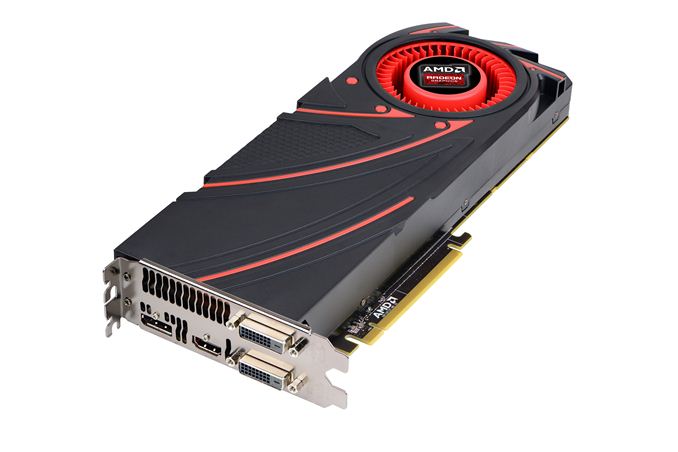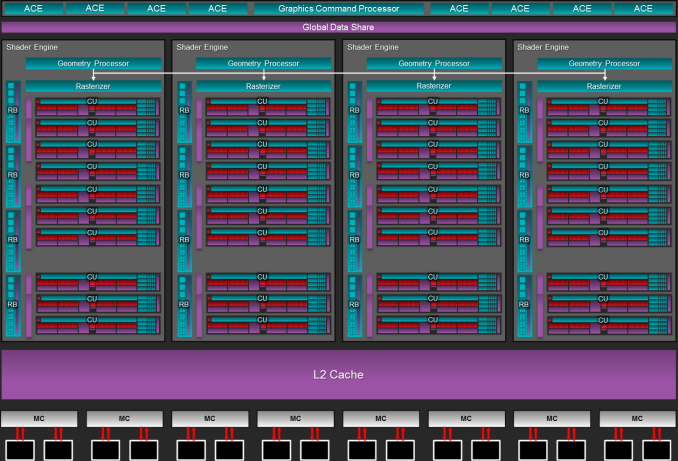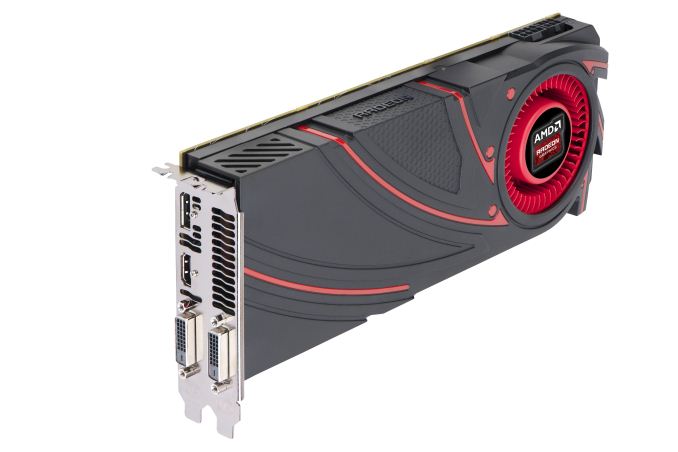The AMD Radeon R9 290 Review
by Ryan Smith on November 5, 2013 12:01 AM EST- Posted in
- GPUs
- AMD
- Radeon
- Hawaii
- Radeon 200

With the launch of AMD’s Radeon R9 290X less than 2 weeks ago, the video card marketplace has become very active very quickly. The 290X not only reasserted AMD’s right to fight for the video card performance crown, but in doing so it has triggered an avalanche of pricing and positioning changes that have affected both NVIDIA and AMD.
NVIDIA for their part cut the price of the GTX 780 and GTX 770 to $500 and $330 respectively, repositioning the cards and giving them their first official price cuts since their spring launches. Meanwhile AMD has also made some changes, and although 290X is unaffected for the moment, 290 was affected before it even launched, receiving an arguably significant specification adjustment. Consequently with GTX 780’s price cut being NVIDIA’s counter to 290X, 290 has gone from just being a lower tier Hawaii card to also being AMD’s counter-counter, and in the process has become a somewhat different card than what it was going to be just one week ago.
But before we get ahead of ourselves, let’s start at the beginning. With the successful launch of the 290X behind them, and the equally successful launch of their new flagship GPU Hawaii, AMD is ready to make their next move. Launching today will be the Radeon R9 290, the obligatory lower-tier part for AMD’s new flagship lineup. Making the usual tradeoffs for a lower-tier part, AMD is cutting down on both the number of functional units and the clockspeeds, the typical methods for die harvesting, in exchange for a lower price. Now officially AMD has not announced the Radeon R9 290 in advance, but with listings for it having already gone up on the same day as the 290X, it’s something that everyone has been expecting.
As always we’ll offer a full breakdown of performance and other attributes in the following pages, but before we even begin with that we want to point out that the 290 is going to be one of AMD’s most controversial and/or hotly debated launches in at least a couple of years. The merits of 290X were already hotly debated in some gaming circles for its noise relative to its performance and competition, and unfortunately 290 is going to be significantly worse in that respect. We’ll have a full rundown in the following pages, but in a nutshell AMD has thrown caution into the wind in the name of maximizing performance.
| AMD GPU Specification Comparison | ||||||
| AMD Radeon R9 290X | AMD Radeon R9 290 | AMD Radeon R9 280X | AMD Radeon HD 7970 | |||
| Stream Processors | 2816 | 2560 | 2048 | 2048 | ||
| Texture Units | 176 | 160 | 128 | 128 | ||
| ROPs | 64 | 64 | 32 | 32 | ||
| Core Clock | 727MHz | 662MHz | 850MHz | 925MHz | ||
| Boost Clock | 1000MHz | 947MHz | 1000MHz | N/A | ||
| Memory Clock | 5GHz GDDR5 | 5GHz GDDR5 | 6GHz GDDR5 | 5.5GHz GDDR5 | ||
| Memory Bus Width | 512-bit | 512-bit | 384-bit | 384-bit | ||
| VRAM | 4GB | 4GB | 3GB | 3GB | ||
| FP64 | 1/8 | 1/8 | 1/4 | 1/4 | ||
| TrueAudio | Y | Y | N | N | ||
| Transistor Count | 6.2B | 6.2B | 4.31B | 4.31B | ||
| Typical Board Power | ~300W (Unofficial) | ~300W (Unofficial) | 250W | 250W | ||
| Manufacturing Process | TSMC 28nm | TSMC 28nm | TSMC 28nm | TSMC 28nm | ||
| Architecture | GCN 1.1 | GCN 1.1 | GCN 1.0 | GCN 1.0 | ||
| GPU | Hawaii | Hawaii | Tahiti | Tahiti | ||
| Launch Date | 10/24/13 | 11/05/13 | 10/11/13 | 12/28/11 | ||
| Launch Price | $549 | $399 | $299 | $549 | ||
Diving right into the hardware specifications, Radeon R9 290 is a bit more powerful than usual for a lower-tier part. AMD has cut the number of CUs from 44 to 40 – disabling 1 CU per SE – while adjusting down the base GPU clockspeed and boost GPU clockspeed to from 727MHz and 1000MHz to 662MHz and 947MHz respectively. However AMD has not cut the amount of memory, the memory clockspeed, the memory bus width, or the number of ROPs, leaving those at 5GHz for the memory clockspeed, 512-bits for the memory bus width, and all 64 ROPs for the back-end hardware.
As a result the differences between the 290 and 290X are on paper limited entirely to the clockspeed differences and the reduced number of CUs. At their top boost bins this gives 290 95% the clockspeed of 290X, and 91% of the shader hardware, giving 290 100% of 290X’s memory performance, 95% of 290X’s ROP and geometry performance, and 86% of 290X’s shading/texturing performance.
Compared to AMD’s last generation offerings, the 290 is going to be closer to 290X than 7950 was to 7970. 290 retains a larger percentage of 290X’s shader and ROP performance, never mind the fact that the full 320GB/sec of memory bandwidth is being retained. As such despite the wider price difference this time around, performance on paper is going to be notably closer. Paper will of course be the key word here, as in the case of 290 more so than any other card we’ve looked at in recent history theory and practice will not line up. Compared to the 290X, practice will be favoring the 290 by far.
Moving on to power consumption, perhaps because of AMD’s more aggressive specifications for their lower-tier card this time around, power consumption is not dropping at all. AMD is still not throwing us any useful hard numbers, but based on our performance data we estimate the 290 to have a nearly identical TDP to the 290X, leading us to keep it at an unofficial 300W. Lower-tier parts typically trade performance for power consumption, but that will not be the case here. Power consumption will be identical while performance will be down, so efficiency will be slipping and 290 will have all the same power/cooling requirements as 290X.
Meanwhile like the 290X launch, the 290 launch is going to be a hard launch, and a full reference launch at that. As such we’ll be seeing 290 cards go up for sale at the usual retailers today, with all of those cards using AMD’s reference cooler and reference board, itself unchanged from the 290X.
As for pricing and competitive positioning, AMD will be launching the 290 at what we consider to be a very aggressive price of $399. Based on the initial specifications, the performance, and the competition, we had been expecting AMD to launch this at $449, mirroring the launch of the 7950 in the process. But AMD has gone one step further by significantly undercutting both themselves and NVIDIA.
290’s immediate competition on the AMD side will be the $549 290X above it and the $299 280X below it, while on the NVIDIA side the competition will be the $499 GTX 780 above it and the $329 GTX 770 below it. Pricing wise this puts 290 as closer competition to 280X/GTX 770 than it does the high-tier cards, but as we’ll see in our benchmarks AMD is aiming for the top with regards to performance, which will make price/performance comparisons both interesting and frustrating at the same time.
NVIDIA for their part will have their 3 game Holiday GeForce Bundle on the GTX 780 and GTX 770, presenting the same wildcard factor for overall value that we saw with the 290X launch. As always, the value of bundles are ultimately up to the buyer, especially in this case since we’re looking at a rather significant $100 price gap between the 290 and the GTX 780.
| Fall 2013 GPU Pricing Comparison | |||||
| AMD | Price | NVIDIA | |||
| Radeon R9 290X | $550 | ||||
| $500 | GeForce GTX 780 | ||||
| Radeon R9 290 | $400 | ||||
| $330 | GeForce GTX 770 | ||||
| Radeon R9 280X | $300 | ||||
| $250 | GeForce GTX 760 | ||||
| Radeon R9 270X | $200 | ||||
| $180 | GeForce GTX 660 | ||||
| $150 | GeForce GTX 650 Ti Boost | ||||
| Radeon R7 260X | $140 | ||||












295 Comments
View All Comments
chizow - Tuesday, November 5, 2013 - link
It's really strange what AMD has done with the 290. Sure it has great price and performance, but AMD has also ramped it up in the key complaint areas, power and noise to get there. As a result, the performance of the 290 is close enough to the 290X that you have to wonder if AMD even wants to sell any 290Xs at all. They are hard enough to find to begin with, but at a $150 price difference for ~5% difference in performance, it seems as if AMD is cannibalizing their own SKUs and dissuading people from purchasing the 290X and choosing the much cheaper 290 instead. It also comes close enough to the 280X while thoroughly stomping it to make the 280X seem much less attractive in that $300-$400 range.In the end the 290 seems like a strong buy for anyone who is willing to tolerate the heat and the noise. It's amazing that the 290 is even hotter and louder than the 290X, even taking the crown from the previous high-end, noisy fireball GTX 480 (thanks for including it in these results this time btw). It's certainly possible AMD wants this SKU to sit by itself in that $400 slot, safely away from the 770/280X below it and the GTX 780/290X above it.
dragonsqrrl - Tuesday, November 5, 2013 - link
The GTX480 is not the previous 'noisy fireball'. AMD has introduced many cards since that make the 480 seem downright reasonable. Take the 6990 and 7970GHz for example. AMD has gone so far and beyond Nvidia in terms of heat and noise it seems comical to still hear people talk about the 480 as though it's some kind of benchmark to compare these cards against. The stock coolers on these recent gen high-end cards from AMD have been much louder.HisDivineOrder - Tuesday, November 5, 2013 - link
Everyone who knows anything knows the FX5800 is the benchmark of loud cards. Seriously, that thing was, is, and will always be the Leaf Blower of Legend.That said, the 290 is a very well executed attempt to catch the myth and make real the loud card of lore we once thought dead and gone.
creed3020 - Tuesday, November 5, 2013 - link
LOL, I too remember the term Leaf Blower being used with the FX5800 for the first time. A friend had it in his rig and we couldn't stop bugging him about it. This was coming from another friend who have three 80 mm Antec Tornados in his case!chizow - Tuesday, November 5, 2013 - link
Agreed that the 480 was probably not as loud, it's fan had issues but didn't have the same high pitched whine characteristic of AMD's blowers. But it was the previously hottest, highest power consuming single-GPU and as an owner of 2 in SLI I can say for sure the heat was a lot to deal with.Mariosti - Tuesday, November 5, 2013 - link
Now think about this:290X with new drivers, and proper cooling enabling it not to just "not throttling" but also to get some minor oc. The difference will be much bigger. That's why nvidia must go all the way with GK110 unlocking to make the 780Ti a viable competitor.
TheJian - Tuesday, November 5, 2013 - link
Or NV can just OC their cards until they hit another 10DB or 50-70watts and laugh right? This is all AMD has done. Why didn't AMD just include this magical fan in the ref design? Overclocks show there isn't much in the tank either. Don't forget they're using NV ref here also. You can buy OC cards that are already clocked 10%+ faster out of the box and reviews show they are quiet in comparison which NOBODY buys.jnad32 - Tuesday, November 5, 2013 - link
The way I look at it, AMD is looking like an absolute genius. Everyone was ripping them on the 290X for it being too hot and too loud anyway. So instead of keeping the sound levels down they just went for what they do best, price/performance. They are now blowing every other card out of the water. There isn't a card on the planet that can touch this card in price/performance. Yea its loud as hell but, at least you have to think about it now just because of the price. What I really want to see is them unleash the 290X sound threshold and see what kind of raw numbers it can put up. Lets be honest, the only people who should buy reference cards are the ones who are putting water blocks on them.Dal Makhani - Tuesday, November 5, 2013 - link
hmm seems like this card in a somewhat "uber mode" fan profile cannibalizes AMD's own R9 290X?HanzNFranzen - Tuesday, November 5, 2013 - link
Ok, fine, the reference cooler sucks. But we all know that sooner rather than later there will be several versions with non-reference coolers available. So instead of get 106% of a 780's performance for $100 lees, we will get it for $70 less. (and possibly some more OC headroom?)Any way you slice it, AMD has done a service for all of us enthusiasts no matter if you're an NVidia or AMD fan... The price/performance has come back down to earth. I will be buying one of these cards, no doubt. But I will be waiting to see what Sapphire or Asus come up with as far as cooling or I may just drop for a 3rd party cooler and a reference board.